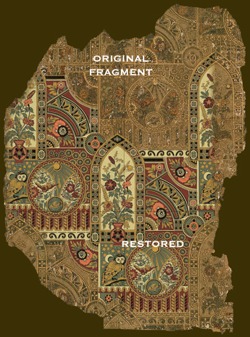Reproduction Services
What to do if you discover old wallpaper in your house that you want to reproduce?
 Where to find it?
Where to find it?
In old homes, old wallpapers can sometimes be found, according to "The Papered Wall," edited by Lesley Hoskins. Large areas or tiny fragments can be found whenever or wherever building alterations or renovations are made.
A few of the places to look are above a false ceiling, behind door frames, picture rails, paneling, fitted bookcases and window shutters, skirting boards, architraves, fire surrounds and under floorboards, according to "The Papered Wall."
"Rooms evolve and, as most of us know from our own decorating efforts, layer upon layer may be revealed on the walls themselves," the book states. Also, historic papers have been used as linings for chests and deed boxes, on band boxes in the U.S., as book covers and on doll house walls, according to the book.
Ceilings also are are a source for old wallpapers, and these also can be reproduced. Some may look just as nice on your ceiling as your wall, and we certainly won't tell anyone you found it on your ceiling.
What to do first?
Before removing the wallpaper to be reproduced, photograph it first. Record the size of the pattern and repeat and the colors. If possible, make note of the kind of paper it is. Does it appear to be handmade sheets? Is it machine-made? It is a good quality rag or a weak wood pulp?
Also record where it was found, the condition of the piece and any identification marks. Where possible, it might be good to make a tracing if doing so would not damage the paper.
How to remove the paper ...
One of the best ways to remove wallpaper from most walls is with a wallpaper steamer. These can be purchased from most home improvement stores and some hardware stores. Follow the basic instructions that come with the steamer.
For removing the wallpaper for reproduction, try to avoid scoring the paper as this will inhibit the reproduction process and reduce accuracy.
If the area to be removed is small or about the size of the steam-plate, hold the steamer on the section to be removed for the recommended amount of time. Once the steamer has had enough time to work, a utility knife can be used to go around the outside of the steam-plate to cut the paper. Use a scraper blade to carefully remove the paper.
If the section you are removing is large, continue steaming small sections with the steamer and scraping the paper away from the wall but keeping the piece intact as best you can. As a last resort, paper can be cut in vertical strips with the utility knife as it is steamed from the wall in strips as wide as the steamer itself. We can piece together several long strips sent to us for reproduction.
There are liquid wallpaper removers that you can buy, but steam works better to salvage the wallpaper.
In addition, there are many ways to store historic wallpaper removed from the wall, but we will not go into those details here.
The reproduction ...
You can refer to the sample you see here online as an example of wallpaper that has been restored from a fragment. To reproduce it, the piece had to be redrawn and colored.
In the reproduction process, colors can change if you don't like the original color. Through our knowledge and research of historic wallpapers, it is possible for us to suppose what the original color might have been based on the age of the pattern and colors which may have been popular at the time.
Estimates for reproduction are available once we have received the sample and had time to analyze what reproduction will entail. The reproduction can be just as detailed, if not more, than the original you send us.
We also can customize colors for every wallpaper in the Aesthetic Interiors line and reproductions.
